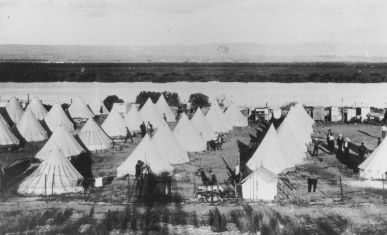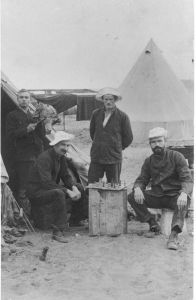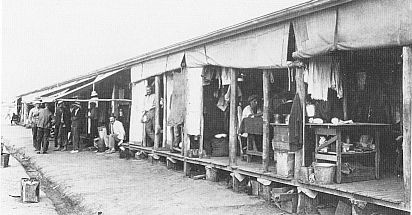![]()
Internment
During the First World War 6,890 Germans were interned, of whom 4,500 were Australian residents before 1914; the rest were sailors from German navy ships or merchant ships who were arrested while in Australian ports when the war broke out, or German citizens living in British territories in South-East Asia and transported to Australia at the request of the British Government. Some internees were temporary visitors trapped here when the war began. About 1,100 of the total were Austro-Hungarians, and of those around 700 were Serbs, Croats and Dalmatians from within the Austro-Hungarian Empire who were working in mines in Western Australia.
Australian trade with Germany and immigration from Germany were banned for the first few years of the 1920s. Officials in the German Department of Foreign Affairs wrote in the 1920s that anti-German feelings seemed stronger in Australia than in any of the other English-speaking countries.
Business Competitors & Union Troublemakers
In World War I the Australian Government wanted to stop companies run by businessmen
of German descent from competing with "British" companies, in case
companies run by German-Australians could somehow help the German war effort
in Europe. An easy way to do this was to intern the directors and managers of
such companies, even if they were naturalised British subjects.
Examples:
| Franz Wallach and Walter Schmidt of the Australian Metal Company (subsidiary of a German company) in Melbourne; | |
 |
Oskar Plate of the Norddeutscher Lloyd Steamship Company in Sydney; |
| Edmund Resch, the Sydney brewer (who had been in Australia for 50 years); | |
| Carl Zoeller, a successful and popular member of the Brisbane German-Australian community and importer and maker of medical and surgical equipment; | |
| Frederick Monzel, publisher and printer of the Queenslander Herald. |
Australian workers and self-employed small-businesspeople needed to feel that they were also contributing something to the Empire's war effort - by recommending to the government that a German-Australian be interned they were being patriotic, but naturally they were especially keen to do so if that eliminated one of their competitors in business. In Melbourne, Mr F.W. Abbott, the manager of "The Neway", a clothes cleaning and dyeing company in Little Collins St, sent the government the names of three competitors who he claimed were German. He wrote:
Cannot Germans trading under British names be made to disclose their names? This applies to all classes of business in Australia. There would be nothing harsh about such a regulation if passed as they will still have an open chance to trade and to get business from those people of Australia who are not loyal enough to stick to their own people.
Obviously Mr Abbott's complaint was in his own business interest. A law was introduced prohibiting enemy aliens from changing their names. A Melbourne waiter sent to the authorities a list of names of "enemy aliens" working in various hotels and cafes in the city. Some professors on the council of the University of Melbourne stopped the appointment of two lecturers of German background. Dr Maximilian Herz, Australia's most distinguished orthopaedic surgeon, was interned. He had played a pioneering role in orthopaedic surgery in this country. The Sydney branch of the British Medical Association (as the Australian Medical Association was then known) cancelled the membership of German-born doctors and campaigned to have them deported. They said:
It is not in the public interest that medical men of alien enemy birth and qualification should be allowed to practise in the Commonwealth.
The Sydney branch of the British Medical Association no doubt did not like the fact that Dr Herz had strongly criticised the standards of Australian doctors at various conferences before the war.
In a court case in Temora, western New South Wales, "a British subject" was accused of having used indecent language in the bar of the Empire Hotel. Police Magistrate N.A. Ormonde Butler dismissed the case because the two witnesses for the prosecution were unnaturalised Germans. He told them:
"You and your friend should be interned. It is a public scandal that the Federal Government allows unnaturalised Germans of military age to work among and in competition with British subjects".
From this it doesn't seem that a national Australian identity was very developed yet at that time; the bond to Britain was very strong. It was not until 1949 that the Australian Government saw its way to introduce Australian citizenship.
The unions were against Germans in Australian workplaces, whether they were
co-unionists or not. The war caused a drop in living standards, higher unemployment
and higher prices, and this created hostility to citizens of German origin.
In some workplaces Australians refused to work with Germans. The Australian
Government saw Germans as troublemakers in workplaces, encouraging strikes in
order to weaken the war effort of the Empire and help Germany.
Examples:
| Ernst Buchwitz, a worker at the Baffle Creek Sugar Mill near Bundaberg and an organiser for the Australian Workers Union, was interned and later deported for having "caused disruption between the men and the mill", a charge Buchwitz denied. | |
 |
C.S. Schache, a waterside worker in Gladstone, Queensland, and "a second-generation Australian with a German grandfather", was interned because he was the local secretary of the Workers' Political Organisation. |
| Willy Gubba in Melbourne was interned because he was a member of the Australasian Socialist Party. He was a waiter in a restaurant owned by a German-Australian, and it was said that the restaurant was used by "all the Germans in and around Melbourne of all classes", according to the detectives who investigated for the Defence Department. There was no evidence, but the detectives concluded that "Probably Gubba as a 'mere waiter' was used as a tool for the other Germans of higher standing and financial position" and the restaurant "was the channel used by the financial opponents to assist the socialists in putting up such a sustained fight against conscription". The Australian Government believed there were German spies all around the country. |
Weaken the German-Australian
Community
- intern the Community Leaders
The Defence Department had a deliberate policy of interning those whom it decided were leaders of the German-Australian community, especially in South Australia and in Queensland, the states with the highest proportion of people of German background, and states in which there were distinctive areas of group settlement (though by 1914 the German-Australians were in the minority in many of these areas). The government wanted to destroy the German-Australian community as a distinct socio-cultural element in Australian society. With this aim, German clubs were closed, Lutheran schools were closed in many places (all of them in S.A. were closed), and the leaders of the community were interned.
Consuls and pastors
Apart from business leaders, the Defence Department saw the consuls and pastors as the leaders in the German-Australian community. The five consuls who were interned in Australia were not professional diplomats, they were honorary consuls, and most were naturalised British subjects. The five were: Eugen Hirschfeld from Brisbane, Ludwig Ratazzi from Perth (of German and Italian background; he was Consul for both countries), Alfred Christian Dehle from Hobart, Otto Johannsen from Newcastle, and Wilhelm Friedrich Christian Adena from Melbourne. As prominent businessmen, their business activities were seen as harmful to British-Australian interests. In South Australia, Consul Muecke was interned for a short time at Fort Largs in April 1916, then from May to October he was under detention in his own home with military guards while his youngest son was fighting in France with the Australian Army after being wounded earlier at Gallipoli. In South Australia Pastor Nickel was interned for a short time, but no other pastors were after that. In Queensland nine pastors were interned, six of whom were naturalised British subjects. Two of those had been born in Australia, including Pastor Friedrich Gustav Fischer of Goombungee. He had been born in South Australia in 1876, and both his parents had also been born in South Australia. Federal Cabinet approved Fischer's internment on the basis of an intelligence report (can 'intelligence' be the right word?!) from the Defence Department which included:
The situation in the German districts gives great anxiety to British residents, and the best way of relieving their anxiety, as well as of keeping German residents in check, is to intern occasionally a few leading German residents. From this point of view it is considered that the internment of Fischer would be justified.
(One can see how society in Australia at that time still felt "British" rather than Australian.)
The Camps
 Internment Camp, Torrens Island, SA, 1914 (State Library of South Australia) |
 Internees, Torrens Island, 1915 (State Library of South Australia) |
Soon after the war started, the Australian government had to set up accommodation for the large number of people who were being interned, so concentration camps (an idea first used by the British Government in the Boer War 1899-1902) were established in each of the six states. In three states (Tasmania, S.A. and W.A.) they were on islands a short distance from the capital city. By the end of May 1915, almost 3,000 people had been interned:
| Enoggera, Queensland (suburban Brisbane) | 137 |
| Holsworthy, NSW (south-east of Liverpool) | 1342 |
| Langwarrin, Victoria (south-east of Melbourne) | 420 |
| Torrens Island, S.A. (in the harbour of Port Adelaide) | 355 |
| Rottnest Island, W.A. (Indian Ocean, near Fremantle) | 628 |
| Bruny Island, Tasmania (south of Hobart) | 58 |
| TOTAL | 2940 |
Two months later the decision was made to close these regional camps and transfer the prisoners to concentration camps in NSW. Perhaps this decision was made in order to save costs (for example, in all camps Australian soldiers who worked as guards had to be paid), in order to make communication between the camps and Melbourne headquarters easier, and to make sure that all guards treated prisoners according to the rules. There had been complaints that guards on Rottnest Island had often used bayonets on prisoners, and on Bruny Island the prisoners had gone on strike, and an official enquiry had been set up into a scandal involving the flogging of prisoners on Torrens Island.
For this centralisation of the internees, the Holsworthy camp was greatly enlarged, and two special camps were also established in NSW, both in jails that were no longer used. The first, at Berrima (130 km south-west of Sydney in the southern highlands), was mainly for ships' officers and sailors, and the Trial Bay camp (on the NSW north coast) was for about 500 internees, most of whom had been deported from British territories in South-East Asia and the Pacific Islands. There was also a family camp at Bourke in the north-west of NSW for overseas internees with wives and children and some female relatives. For many internees the long-distance journey from their regional camp to their new camp in NSW was unpleasant. Many complained about rough treatment by police or military officials. Many were handcuffed during their train journey; being treated in public as if they were criminals would not have been pleasant. The luggage of many prisoners was lost en route, and some found that their luggage had been forced open and things had been stolen.

Internment Camp, Holsworthy, NSW
In the camps the internees arranged their own entertainment and many cultural and sporting events. They formed choirs and orchestras, and had theatrical productions. Dr Maximilian Herz directed many successful productions at Trial Bay. At Berrima the sailor prisoners built many different model boats and had regattas and boat exhibitions on the Wingecarribee River. At one exhibition early in 1918 the local public were surprised to see a Venetian gondola, a scale model of the sailor-training ship Preußen, a Chinese junk and a submarine. The Berrima prisoners were also allowed to work for money on local farms.
Summarised from:
Fischer, Gerhard. 1989. Enemy
aliens: internment and the homefront experience in Australia, 1914-1920.
University of Queensland Press, St Lucia (Qld).
Tampke, Jürgen and Colin Doxford. 1990. Australia,
Willkommen. New South Wales University Press.
| Top | Back
| Chronology | Issues
| Students | Site Map |
auf Deutsch |
| Primary Sources (in German) | Bibliography
| Search |
German Australia © D. Nutting 2001